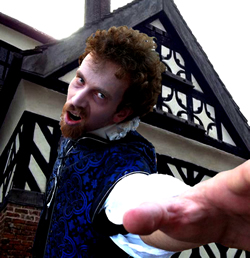In Varick Auditorium of Livingstone College, the Salisbury Symphony Orchestra presented its third concert of the season, “Breaking Tradition,” under the baton of Music Director David Hagy, featuring works by the Three B’s: Brahms, Beethoven, and … Barber, not Bach, as one might suppose, and thus the title of the concert.
The program opened with Johannes Brahms’ (1833-97) Variations on a Theme by Haydn, Op. 56a. The theme is based on the St. Anthony Chorale, and was almost certainly not written by Haydn but one of his students, not that anyone is going to petition to change the title now. The opening theme is presented as it was in the original work, by oboes and bassoons, now supported by strings and horns. Then it takes off in eight variations, each retaining the original melody, and a finale in which Brahms constructed a grand Baroque passacaglia, a set of variations built on a repeated base line. Using a chamber-sized orchestra, the finely tuned details and all of the intricacies of the piece were able to shine through, providing a very fine reading of the work.
Samuel Barber (1910-81) was one of the few 20th century composers who did not break tradition, despite the title of this concert. He strove to keep all of his works melodic, and in this he did not fail with his “Capricorn” Concerto for flute, oboe, trumpet, and string orchestra. Here he used the Baroque concerto grosso as a model, writing a work with three movements, each with fast, slow, and fast sections. The featured soloists were Carla Copeland-Burns, flute, Anna Lampidis Glantz, oboe, and Gregory Hall, trumpet. Each of the soloists hold their respective principal chair in the Salisbury Symphony, and each have a busy teaching and performing schedule in addition.
In this concerto, the soloists each have prominent roles alone and in ensembles of various combinations. Filled with rhythmic twists and turns and off-beat syncopations, this work is imaginative and entertaining, and each of the soloists and the orchestra played their very difficult parts skillfully and with spirit.
What better tribute to a beautiful day on the first day of spring than to play Ludwig van Beethoven’s (1770-1827) Symphony No. 6 in F, Op. 68 (“Pastoral”). This symphony represents the expression of the love the composer held for nature. In it, Beethoven broke with the past, writing five movements instead of the then-customary four. He also assigned programmatic titles to each of the movements, and the fourth movement is quite possibly one of the best musical depictions of a storm ever written. Maestro Hagy conducted this performance using some very rapid tempos, but the orchestra had no trouble in keeping up and articulating each and every note with clarity. The storm sequence was filled with tension and trembling and loud thunder claps, finally giving way to a ray of sunshine and the final “Pastoral Song –Feelings of joy and gratitude after the Storm.” This was a lustrous performance of one of the world’s great symphonies, and the orchestra, like the sun, shone through.
So as not to slight the “real” third B, the orchestra played Johann Sebastian Bach’s (1685-1750) “Air on a G String” as an encore, also with great lushness and feeling, to a very appreciative audience.












